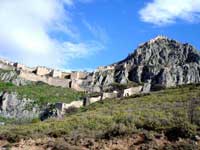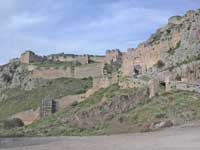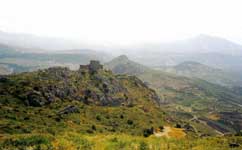.
Administrative Region : Peloponnese
Regional unit : Korinthia
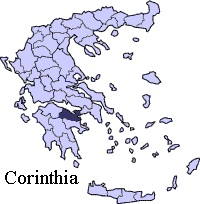
Corinthia
Korinthos, Corinth (Greek Κόρινθος, Kórinthos) ([ˈkorinθos] ( listen)) is a city and former municipality in Corinthia, Peloponnese, Greece. Since the 2011 local government reform it is part of the municipality Corinth, of which it is the seat and a municipal unit.[1] It is the capital of Corinthia.
It was founded, as Nea or New Corinth in 1858, after an earthquake destroyed the existing settlement of Corinth, which had developed in and around the site of ancient Corinth.
Location
Located about 78 kilometres (48 mi) southwest of Athens, Corinth is surrounded by the coastal townlets of (clockwise) Lechaio, Isthmia, Kechries, and the inland townlets of Examilia and the archaeological site and village of ancient Corinth. Geophysically the city is likewise surrounded by the narrow coastal plain of Vocha, Corinthian Gulf, Corinth Canal, the Isthmus of Corinth, Saronic Gulf, Oneia Mountains, and the monolithic rock of Acrocorinth, where the medieval acropolis was built.

Aerial view of Corinth, Greece looking from North to South [Source]
History
Main article: Ancient Corinth
Corinth derives its name from Ancient Corinth, a city-state of antiquity. In 1858, the old city of Corinth (now known as Archaia Korinthos (Αρχαία Κόρινθος), located 3 km (1.9 mi) SW of the modern city), was totally destroyed by an earthquake. This led to the establishment of Nea or New Corinth, on the coast of the Gulf of Corinth. New Corinth was rebuilt after a further earthquake in 1928 and again after a great fire in 1933.
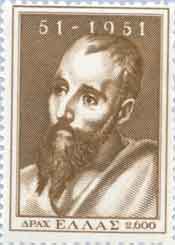
Paul stamp 1951, Greece, 1900 years since his visit to Corinth
Further information: 2008 Greek riots and 2010-2011 Greek protests
Population
Corinth is the second largest city in the periphery of the Peloponnese after Kalamata (53,659 inhabitants in 2001). In the 1991 census, the city had a population of 28,071, while the latest data (2001) showed an increase of 2,363 inhabitants (+8,4%), to 30,434. Between the census of 1981 and 1991, the city had one of the fastest-increasing populations in the country.[CN]
The Municipality of Corinth, or Dimos Korinthion, had a population of 36,991 in 2001. The municipality includes the town of Archaia Korinthos (1,770 inhabitants), the town of Examilia (1,547 inhabitants), and the smaller settlements of Xylokeriza (777 inhabitants) and Solomos (686 inhabitants).
Port
The port of Corinth, located north of the city centre and close to the northwest entrance of the Corinth Canal, at 37 56.0’ N / 22 56.0’ E, serves the local needs of industry and agriculture. It is mainly a cargo exporting facility.
It is an artificial harbour (depth approximately 9 metres (30 ft), protected by a concrete mole (length approximately 930 metres, width 100 metres, mole surface 93,000 m2). A new pier finished in the late 1980s doubled the capacity of the port. The reinforced mole protects anchored vessels from strong northern winds.
Within the port operates a customs office facility and a Hellenic Coast Guard post. Sea traffic is limited to trade in the export of local produce, mainly citrus fruits, grapes, marbles, aggregates and some domestic imports. The port operates as a contingency facility for general cargo ships, bulk carriers and ROROs, in case of strikes at Piraeus port. There is a ferry line (RORO) connecting Corinth to Italy.
Industry
Corinth is a major industrial hub at a national level. Copper cables, petroleum products, medical equipment, marble, gypsum, ceramic tiles, salt, mineral water and beverages, meat products, and gums are produced nearby. As of 2005, a period of de-industrialization has commenced as a large pipework complex, a textile factory and a meat packing facility disrupted their operations.
Transport
Corinth is a major road hub, being the entry point to the Peloponnesian peninsula, the southernmost area of continental Greece.
The city has been connected to the Proastiakos, the Athens suburban rail network, since 2005, when the new Corinth railway station was completed.
Sport
The city's association football team is Korinthos F.C. (Π.Α.E. Κόρινθος), established in 1999 after the merger of Pankorinthian Football Club (Παγκορινθιακός) and Corinth Football Club (Κόρινθος). During the 2006-2007 season, the team played in the Greek Fourth Division's Regional Group 7. The team went undefeated that season and it earned the top spot.[2] This granted the team a promotion to the Gamma Ethnikí (Third Division) for the 2007-2008 season. For the 2008-2009 season, Korinthos F.C. competed in the Gamma Ethniki (Third Division) southern grouping.
International relations
Twin towns — Sister cities
See also: List of twin towns and sister cities in Greece
Corinth is twinned with:
Italy Syracuse, Sicily[3]
Serbia Jagodina, Serbia
United States Abilene, TX, United States
Canal
Main article: Corinth Canal
The canal cuts through the Isthmus.
The Corinth Canal, carrying ship traffic between the western Mediterranean and the Aegean Sea, is about 4 km east of the city, cutting through the Isthmus of Corinth.
See also
List of traditional Greek place names
Corinth Canal
Corinth Excavations
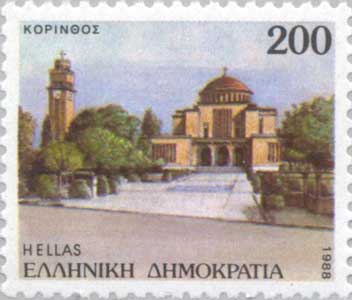
Corinth Stamp,Church of St. Paul , "Agios Pavlos"
Notable people
George Kollias (1977-), drummer for US technical death metal band Nile.
Ioannis Papadiamantopoulos (1766–1826), revolutionary leader during the Greek War of Independence.
Irene Papas, Greek actress
| Municipal unit Korinthos |
|---|
| Municipal Community Archaia Korinthos |
| Αρχαία Κόρινθος, η |
| Αρχαίο Λιμάνι, το |
| Municipal Community Examilia |
| Agios Kosmas (Άγιος Κοσμάς, ο) |
| Dafni (Δάφνη, η) |
| Examilia (Εξαμίλια) |
| Ιερά Μονή Αγίας Τριάδος, η |
| Kato Examilia (Κάτω Εξαμίλια) |
| Municipal Community Korinthos |
| Korinthos (Κόρινθος, η) |
| Community Xylokeriza |
| Αγία Παρασκευή, η |
| Άγιος Δημήτριος, ο |
| Thymariona (Θυμαριώνα, η) |
| Kechries (Κεχριές, οι) |
| Xylokeriza (Ξυλοκέριζα, η) |
| Πανόραμα, το |
| Community Solomos |
| Bekianika (Μπεκιάνικα) |
| Solomos (Σολομός, ο) |
| Ancient Greece
Science, Technology , Medicine , Warfare, , Biographies , Life , Cities/Places/Maps , Arts , Literature , Philosophy ,Olympics, Mythology , History , Images Medieval Greece / Byzantine Empire Science, Technology, Arts, , Warfare , Literature, Biographies, Icons, History Modern Greece Cities, Islands, Regions, Fauna/Flora ,Biographies , History , Warfare, Science/Technology, Literature, Music , Arts , Film/Actors , Sport , Fashion --- |
From Wikipedia, All text is available under the terms of the GNU Free Documentation License



